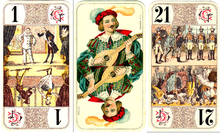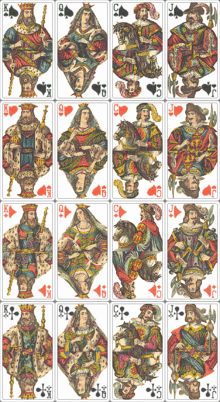Tarot Nouveau

Tarot Nouveau oudlers circa 1910
The Tarot Nouveau, French Tarot Nouveau or Bourgeois Tarot deck is a general style of tarot playing card deck. The Tarot Nouveau differs from other styles of tarot deck, such as the Tarot of Marseilles and Rider-Waite decks, in that the Tarot Nouveau is designed solely for playing the various tarot card games for which the 78-card tarot deck was originally devised, such as French Tarot. In the French language, this deck is often called the tarot à jouer or playing tarot. This usage is distinct from cartomancy and other divinatory purposes, for which the tarot is most commonly known outside Continental Europe. This deck is most commonly found in France, Wallonia, Suisse romande, Quebec, and Denmark.
Origin

An early German Tarock trump card, showing center indices
This pattern is said to have originated in the late 19th century with the C.L. Wüst cardmaker of Frankfurt Germany. This earlier edition lacked the corner indices found on the later 20th century version published by French cardmakers such as Grimaud, but the values of trumps changed from Latin numerals common on older decks to Arabic numbers used in modern writing. These numerals were placed in the center of the panels in a Fraktur font similar to cards which were used for the German Tarock game of Cego. In the early 1900s, French cardmakers such as Grimaud appropriated this pattern and would later add the corner indices now found on most modern card decks.
Cards
The cards bear the French suits of Spades, Hearts, Diamonds and Clubs, rather than the Italian suits of Swords, Cups, Coins and Wands (typical in tarot decks used for cartomancy) or the traditional German suits of Hearts, Bells, Acorns and Leaves (commonly seen on Tarock and Skat decks in East Germany, Austria and Hungary). The "pip" and court cards of the Tarot Nouveau (which are called the Minor Arcana in cartomancy) are similar in format to those of the traditional 52-card deck, with the addition of the Knight (Chevalier) face card.
The atouts or trumps depict genre scenes of whimsical early 19th-century social activities of the well-to-do European bourgeoisie, hence a common alternate name for this deck, the "Bourgeois Tarot". This is in contrast to the trionfi of Italian Tarocco decks and the Major Arcana of "esoteric" decks used for cartomancy, which have allegorical illustrations and, in cartomancy, interpretive meaning.
All cards use corner indices as opposed to the top-center indices of older tarot decks and their "esoteric" descendants used for readings; this allows the cards to be held in a single hand as is required for many card games. They also include reversible art for court and trump cards while traditional and modern reading tarots have full-length character art.
Composition

Tarot Nouveau court cards with English indices
The Tarot Nouveau deck, like most (but not all) tarot decks, is composed of 78 cards. 56 are suited in the traditional French suits, with 14 cards per suit; ten "pip" cards with values 1-10 (the Ace bears the number 1 instead of the familiar "A", and usually ranks low), and four court cards: Jack (Valet), Knight (Chevalier or Cavalier), Queen (Dame) and King (Roi). The other 22 are the 21 atouts or trumps and one Fool. The deck is thus primarily different from the 52-card Poker deck in the existence of the separate trump "suit", and the addition of the Knight court card. With these cards removed the deck is identical to the 52-card deck for playing purposes. The face cards do not use the Parisian pattern (portrait officiel) but have their own unique illustrations. The Fool, though similar in appearance and function to the Joker card of poker decks, has differing origins (see Joker for more information).
Trumps
The 21 trumps in a Tarot Nouveau deck each have two scenes taking up the graphic portion of the card, in a roughly reversible fashion (one scene is always face-up), but unlike the court cards which have similar reversible art, most of the cards' scenes are not rotationally symmetrical. Each card has one scene show an "urban" representation of a particular trait or idea (listed below), while the other side depicts a more "rural" interpretation. These themes, instead of the more historic depictions ("Major Arcana"), was chosen to represent tarot trumps in Unicode 7.0. The scenes depicted are as follows:
| General theme |
Card Number |
Card Theme |
Urban Representation |
Rural Representation |
| The four ages |
2 |
Childhood |
Children playing in the park |
Boys playing at the fête |
| 3 |
Youth |
Group of youths in the park |
Three maidens in town clothes |
| 4 |
Maturity |
In the Office |
Women with children |
| 5 |
Old Age |
The Grandfather |
The Grandmother |
| The four times of day |
6 |
Morning |
Breakfast |
Mowing the Wheat |
| 7 |
Afternoon |
Discussion in the Parlour |
Rest in the Field |
| 8 |
Evening |
The Music Room |
The Family Reunited on the Doorstep |
| 9 |
Night |
Returning home after hunting |
The Night Watch |
| The four elements |
10 |
Earth |
|
The Mine |
| Air |
|
Shepherd in the Mountains |
| 11 |
Water |
|
Boating on the Lake |
| Fire |
|
The Picnic |
| The Four Leisures |
12 |
Dance |
Soirée |
Folk Dance |
| 13 |
Shopping |
The Store |
The Village Store |
| 14 |
Open air |
Hunting |
Fishing |
| 15 |
Visual Arts |
Photography |
Painting |
| The Four Seasons |
16 |
Spring |
Gardener in the Park |
Sheep Shearing |
| 17 |
Summer |
At the Races |
Drying the Wheat |
| 18 |
Autumn |
At the Market |
Threshing Wheat |
| 19 |
Winter |
Skating |
The Vigil |
| The Game |
20 |
The Game |
Cards |
Bowling |
| Folly |
21 |
Collective |
The Carnival |
The Military Parade |
| 1 |
Individual |
The Sad Clown |
The Fool and the Ballerina |
COMMENTS








 Tarot Nouveau oudlers circa 1910
Tarot Nouveau oudlers circa 1910 An early German Tarock trump card, showing center indices
An early German Tarock trump card, showing center indices Tarot Nouveau court cards with English indices
Tarot Nouveau court cards with English indices